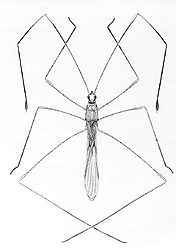This page has been archived and is being provided for reference purposes only. The page is no longer being updated, and therefore, links on the page may be invalid.
|
Read the magazine story to find out more. |
New Stilt Bug Species DiscoveredBy Luis PonsJuly 24, 2002 Two new species of stilt bugs, a common and diverse group of insects that includes both friend and foe to agricultural crops, have been discovered by an Agricultural Research Service scientist. Entomologist Thomas J. Henry of the ARS Systematic Entomology Laboratory, Washington, D.C., has described a species new to science from Vietnam–Yemmatropis erectus. He found this predatory stilt bug at the Bernice Bishop Museum in Honolulu, Hawaii, among specimens that had been collected by scientists during a faunal survey of Southeast Asia. Another new species recognized by Henry, Hoplinus paulai, is--like most stilt bugs--poorly known. The genus Hoplinus is found from the western United States and Canada south to Argentina and southern Brazil and Chile. But H. paulai is known only from the state of Minas Gerais in Brazil. Stilt bugs are a relatively small group of unusual hemipterans, or true bugs, that possess long, slender legs, leathery front wings and membranous hind wings. Most notably, their legs and antennae are often longer than their bodies. While some are beneficial and prey on crop pests such as aphids, mites, cotton budworm and tomato hornworms, others are serious pests of tomato, cotton and cacao. Despite the abundance of some stilt bugs, the habits and hosts of most species are unknown. According to Henry, recognition of these stilt bugs will assist quarantine and regulatory agencies in halting potentially important foreign species from entering the United States. Read more about this finding in the July issue of Agricultural Research magazine. ARS is the U. S. Department of Agriculture's chief scientific research agency. |

